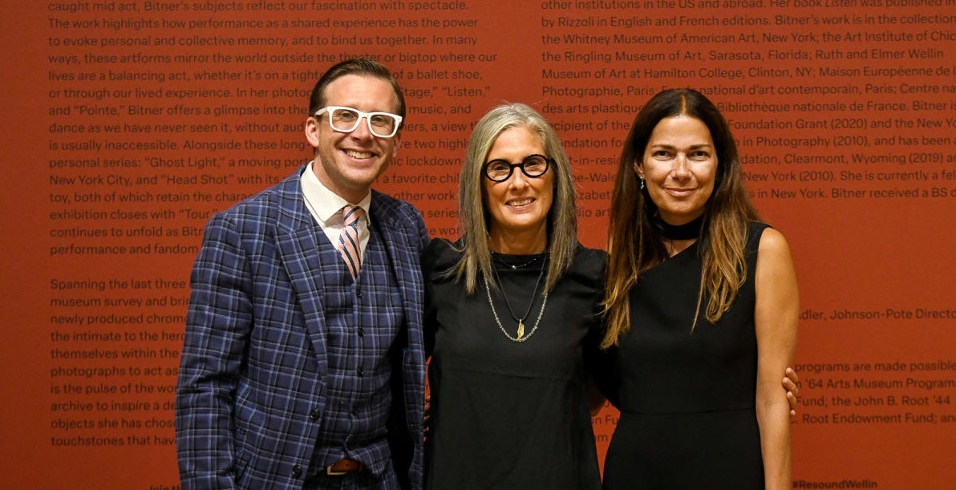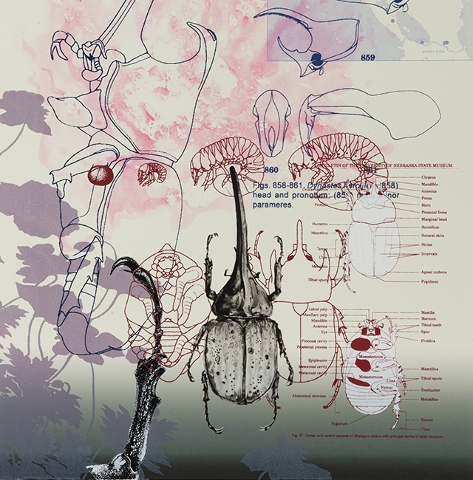Heather Ainsworth

September 27, 2023
Over the past twelve months, I have been fortunate to work closely with artist Rhona Bitner and our director Tracy Adler, who curated the exhibition Rhona Bitner: Resound for our museum. I recently had the chance to reflect on our collaboration and ask Bitner about her experience of working with us. What follows is an edited version of my correspondence with the artist.
 |
|
Untitled, from "Ghost Light," 2020 |
Alexander Jarman: You've shared with me that the process of planning this exhibition with the Wellin Museum has helped you learn how to talk about your work differently and allowed you to see your work in new ways. What are one or two things you've learned about your photographs or your practice overall as a result?
Rhona Bitner: I work alone and my projects are rigorous, each requiring multiple levels of obtaining official permissions and a thorough dedication of time. So, the opportunity to pause and focus my voice—as much as I do my vision—is fundamental. This exhibition is the first opportunity I have had to see the arc of my work, printed to scale and assembled together in one place. Looking around the gallery, relationships between works became evident, especially some that I had not previously identified. Working so closely with Tracy Adler and yourself pushed me to articulate those connections in a more precise way.
For example, Tracy insisted that my Covid lockdown project, Ghost Light, be included when I was convinced it didn’t belong. The fact that this great, teeming city of New York was empty refers back to a dark moment in our lifetimes but also back to what I have said about music—it is both a personal and collective experience. I walked through my darkened hometown by myself but the memories and heartbreak of the city’s inhabitants walked alongside me. Just like when I stood alone in the empty venues depicted in Listen, standing in the city alone allowed space for memory, both my own and those of the millions of people who were absent. I didn’t really understand this until I spent time in the gallery and saw the 77 photographs from this series sharing space with the other projects.
 |
|
FAME Recording Studios, Studio A, Muscle Shoals, AL, May 8, 2008, from “Listen,” 2006–18 |
AJ: The earliest series in the exhibition, Circus, features 39 photographs that all—conceptually and compositionally—center the performer(s). Other bodies of work, such as Listen or Stage, depict spaces where people often gather for performances but your images are devoid of performers. In Pointe, you lovingly depict shoes that no one is wearing. In Ghost Light, whenever I spy a small figure it only seems to reinforce the emptiness around them. And in one of your more recent series, Tour, there are two photographs of music fans packed together at a concert. Can you talk about some of the ideas that inform your decisions to include or exclude people in your work? And how do you think the presence or absence of people affects viewers' interpretation of the spaces being represented?
RB: There is no conscious exclusion or inclusion, it is not the deciding factor. So, it is hard for me to answer your question as such. Either way that palpable absence or presence is inherent to the work. The shoes in Pointe were worn by a figure. You may not see her but those markings are entirely unique to that ballerina and how she dances, she is absolutely present in the marks her gestures and strength left on the shoe. It is a portrait even though you don’t see her face. I hope that is clear to the viewer. The microphone in FAME Recording Studios, Studio A, Muscle Shoals, AL, May 8, 2008, held the breath and transmitted the voice of a performer whose voice arrested us all. The acrobat balancing plates or hanging by a thread in Circus reflects back to us that which we do as we try to get through each day. To paraphrase Oscar Wilde, “theatre is the most immediate way in which a human being can share with another the sense of what it is to be a human being.” Whether you can “see” the figures or not, they are most decidedly there—one must choose to acknowledge them.
 |
|
96-108-BA, 1996, from “Circus,” 1991–2001 |
AJ: Picking up on that excerpt by Wilde, I love that the wall text for your show at the Wellin includes so many wonderful quotations by a wide range of writers and artists, including Susan Sontag, Samuel Beckett, Oscar Wilde, Marcel Proust, Martha Graham, John Cage, and Neil Young. I know you have an impressive library at your home and I am curious to know how you think reading about art and performance has perhaps influenced the way you contextualize your own practice.
RB: Cicero said “A room without books is like a body without a soul.” Reading is where we go to learn and explore and discover, right? When I read I visualize, I find phrases or ideas or images that take my thoughts in a direction I hadn’t previously considered. I have bits of paper with quotes and sentences and poems scribbled on them everywhere in my studio. It is always about curiosity and discovery. Without that we wither and dry out. Indeed, it was that one line in Samuel Beckett’s novel “Company” that gave voice (excuse the pun) to what I couldn’t quite articulate when I first made the Circus images: “A voice comes to one in the dark. Imagine.” Says it all, doesn’t it?
AJ: Lately when I take walks through your exhibition, I have been thinking about the concept of ekphrasis. While I realize your work does not perfectly fit the definition of ekphrasis, you are often making art based on other (performing) art forms. What are some of the elements of performing that you admire or find so inspirational?
RB: What a wonderful word. I never would have thought of it in relation to my work. Thank you. Maybe you have hit on something. Technically ekphrasis is about language or the “phrasing of a work of art” isn’t it? Photography has been described as writing with light so perhaps we could stretch it that far. But am I wrong in thinking that ekphrasis can also be defined as a sort of enthusiastic or interpretive encounter between two different artistic representations? If so, it might indeed be close to what I am doing. Much more so than “documenting” which is a word often misused in relation to my work.
AJ: Let’s circle back to where we started. Working on an exhibition such as yours reminds me that museums are special, in part, because unlike the artist's studio or most galleries they can display a large amount of an artist's work in one space. In this case viewers will be able to see works you have made over the course of 30 years, thus allowing them to make connections between different series. And while you've always been open to the idea that viewers will create their own interpretations of your work, I was wondering if you could offer one or two ideas that you hope Wellin audiences will take away with them after visiting your exhibition?
RB: Yes, this somewhat relates back to what I said in answer to your first question… what I hope very much is that viewers understand this work is meant to draw them in so that they might reflect on their own experiences, emotions, and memories. But I hope they will also take away the commonality of these notions … how much we share as human beings, what the human experience is at its core. We’re all in this together. If we remember and respect what we have in common perhaps we’ll appreciate and respect what makes us different with more value, care, and consideration.
But museums are much more than very special, the Wellin in particular. This opportunity has been the long-awaited validation of my work. It is an overwhelming adventure of discovery and a most joyful one. I am so grateful to Tracy Adler, the entire Wellin family, and Hamilton College for this honor.







